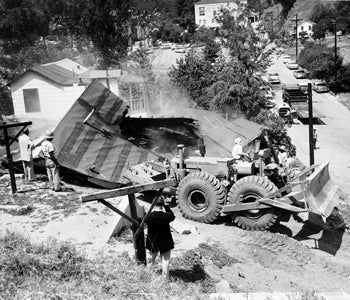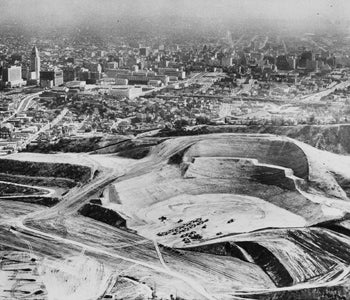Homing in on a Ph.D.
Imagine a day at Dodger Stadium in Los Angeles: The checkered pattern of freshly cut grass outlines the red-brown dirt that makes up the baseball diamond. As you settle in for the game, you tear open a bag of salty, shelled peanuts.
When the batter slides onto home plate, you cheer on your team.
When most people think of stadiums, they think about what goes on inside. But Priscilla Leiva focuses her attention on communities surrounding large sports stadiums. At Dodger Stadium, she is more interested in the neighborhood of Elysian Park obscured by the stadium walls.
Leiva, a Ph.D. student in American studies and ethnicity in USC Dornsife, examines the complicated relationship between stadiums and their surrounding communities of color. The research has earned her a coveted Mellon/American Council of Learned Societies (ACLS) Dissertation Completion Fellowship. The award will allow her to finish her doctoral dissertation during the 2013-14 academic year.
The Mellon/ACLS Dissertation Completion Fellowship supports a student’s last year of Ph.D. dissertation writing and research in the humanities and related social sciences. Nationwide, 65 fellowships are awarded each year.
Leiva’s research explores the history of four sports stadiums in the United States from World War II to the present. She is looking at the role stadiums play in creating civic identity in the cities where they are located, as well as their relationship with surrounding communities of color. In addition to Dodger Stadium, Leiva is studying Robert F. Kennedy Memorial Stadium in Washington, D.C., the Reliant Astrodome in Houston, Texas, and the Mercedes-Benz Superdome in New Orleans, La.

Initially promised new, affordable housing, residents of the Chavez Ravine community in Los Angeles in 1959 were evicted and their homes razed to make way for Dodger Stadium. Courtesy of University of Southern California, on behalf of the USC Special Collections.
Take Dodger Stadium, for instance. The neighborhood of Chavez Ravine once thrived on the land where the ballpark now stands. There, in the 1950s, a close-knit Mexican American community was forced from their homes under eminent domain to make way for the development of affordable housing. Instead of building public housing as promised, the city razed the Chavez Ravine homes and gifted the land to build the baseball stadium.
Fast forwarding to the present, Dodger Stadium has become an important place for Latinos in L.A. to come together to celebrate their beloved baseball team and their city, Leiva said.
“The story of Dodger Stadium is a really important one,” Leiva said. “It’s an example of how we can explore the question of what it means if stadiums are a site of removal for some communities, and under what conditions do they return? What are the politics of that?”
As a national narrative, her dissertation will also analyze how Kennedy Memorial Stadium (formerly D.C. Stadium), replaced Griffith Stadium, located in a predominately African American community. She will look at what it meant for the neighborhood stadium to be removed and replaced by a federally owned stadium in 1961 at a time when sports was becoming desegregated. Leiva will then look at the world’s first domed stadium able to control its environment — the Astrodome. She will investigate what it meant to build the stadium during the civil rights era.
Leiva will also study the role that the Superdome played in New Orleans during Hurricane Katrina, when more than 20,000 people sought shelter at the stadium. Unprepared with enough water and food to support evacuees, the stadium quickly became highly unsanitary and unsafe. For many local residents, this was their first time inside the structure.
Studying urban history through stadiums is a new approach to the discussion of civic identity and race, said George Sanchez, professor of American studies and ethnicity and history, and Leiva’s adviser.
“Priscilla is not just looking at particular groups and their history, but how race and differences now inform large discussions in major urban areas across the United States,” said Sanchez, vice dean for diversity and strategic initiatives. “She is looking at race in a very complicated and dialectical way.”
In her archival work, Leiva looks at newspapers and oral histories. She also visits the cities where the stadiums she is studying are located. She studies promotional materials and how teams build fans and thwart violence at games.
Leiva noted that her research comes at a time when L.A.is discussing the possibility of a football stadium in the city.
“Part of what I’m asking is how did we get to a point where stadiums feel more necessary than public services, schools and other projects for cities?” she said.

Aerial view of Chavez Ravine excavated to make way for Dodger Stadium (1960). Courtesy of University of Southern California, on behalf of the USC Special Collections.
Leiva was drawn to the topic because of her love for Los Angeles. The idea for her dissertation grew from her senior thesis as a Mellon Mays undergraduate fellow at Yale University, where she majored in American studies. Her paper explored the punk rock subcultures of L.A. after the 1992 civil unrest. Leiva, a Latina who grew up in L.A. and attended punk rock shows as a teenager, analyzed the ways in which so-called punk rockers appropriated southeast L.A. venues that had previously excluded Latinos and made them their own.
Though Leiva doesn’t describe herself as a baseball fan, she remembers going to Dodger games in high school. She loved the camaraderie of people from different neighborhoods in L.A. coming together for a ballgame.
“I sat out in the Left Field Pavilion, which has its own subculture,” Leiva said. “In some ways it tends to take over Dodger Stadium because it’s the rowdiest. For me, it’s not too far from thinking about punk subcultures.”
Leiva’s goal is to become a professor in American studies, or a similar field. Working with Sanchez has helped her home in on the type of instructor she aims to be, she said.
During her time at USC Dornsife, Leiva has worked closely with Sanchez on a number of projects including the Summer Immersion Program he heads, in which Norman Topping Student Aid Fund scholars participate in a month-long academic program in L.A. and Japan. The student funding supports low-income students committed to community service. Like Leiva, many students in the program are also first-generation college students.
“Working with Norman Topping Scholars has made me invested in mentorship as part of teaching,” Leiva said. “I have great ideas about what you can do for first-generation college students, and I’m going to take those with me wherever I go.”